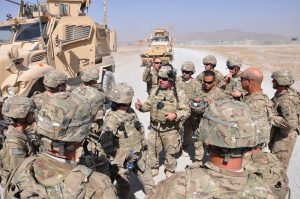Jacob Gekht’s take
September 20, 2021
The reason for the 2003 US invasion of Afghanistan was plain and simple, to find and eliminate Al-Qaeda and its leader, Osama Bin Laden. Nearly 20 years later, it is clear that the intended purpose of the US’ prolonged stay in Afghanistan was not the one that the American people expected.
This 20-year war, the longest in the United States’ history, ends in debt, broken dreams, and the deaths of thousands. So now that the traditional war in Afghanistan is over, it is time to ask why the conflict ended in this chaotic evacuation, who’s at fault, and what will happen next.
Despite all predictions, the republic of Afghanistan, with 300,000 soldiers with “advanced weaponry,” as Joe Biden stated, had fallen. While a military withdrawal was planned, the full withdrawal of US officials, citizens, and allies had not been planned until the Taliban gained control of the majority of the capitol, Kabul.
The collapse of the US-backed regime was seen as inevitable in some parts of the intelligence community, with about 6 months given for the Afghan military to hold out.
General Mark Milley, chair of the Joint Chiefs of Staff, stated that “There are no reports that I am aware of that predicted a security force of 300,000 would evaporate in 11 days.”
To the surprise of everyone, however, the Taliban took the nation in about 7 days. In reaction to the failure of the Afghan Military, the administration panicked and began an evacuation that could’ve been planned earlier.
Even before the military withdrawal took place, multiple reports stated that the central government was on the verge of collapse, losing strategically important roads outside their supposed bastion of Kabul.
With multiple warning signs coming from reputable sources indicating that a complete withdrawal would lead to chaos, the administration ignored warnings of collapse and decided to withdraw US forces without securing American citizens and Afghan allies.
This move proved to be incredibly foolish and dangerous, and soon enough, it showed.
As the Taliban took over the majority of the nation, and panic ensued, the US had to get its troops back into the warzone to evacuate thousands of people. This came at a cost: hundreds of civilians died due to terror attacks and stampedes, and 13 US service members were killed in a bombing.
No matter who receives the blame, this operation was a failure. The main objective was to save Americans, but the rushed evacuation did just the opposite— it put civilians, allies, and soldiers in harm’s way.
The US citizens who died were several selfless souls laying down their lives to get people to safety.
Joe Biden, on damage control, not only blames it on previous administrations and Afghans but claims the mission was a success. Biden said in a speech to the nation, “The extraordinary success of this mission was due to the incredible skill, bravery and selfless courage of the United States military and our diplomats and intelligence professionals.”
This mission was not a success. Even the evacuation itself wasn’t a success, with Secretary of State Antony Blinken saying, “We believe there are still a small number of Americans – under 200 and likely closer to 100 – who remain in Afghanistan and want to leave.”
The mission wasn’t accomplished. Without any protection, and thousands of miles away from any US military base, the contingent of Americans and Afghan allies left in Afghanistan will have to stay for a longer period of time.
Looking forward, the situation is rather grim.
Similar to the 1990s in Afghanistan, the Taliban have control, and this will have major consequences for the entire region. The United States has left the nation and abandoned all military bases, despite this, continued involvement is highly likely, as retaliatory strikes against Isis-K have already happened and are expected to continue. The side effects of drone strikes have already been exposed, as one strike has already killed 10 civilians.
While the ground war is over, US airstrikes on terrorist targets will cause the death count to rise, and continue the humanitarian crisis that has caused millions to seek refuge in neighboring countries.
With Sharia Law being reinstated through the new “Islamic Emirate of Afghanistan,” the human rights that Afghans had while living in democratic Afghanistan will be gone. These rights being freedom of speech, right to a fair trial, women’s rights, and others.
When the dust settles, and the international attention shifts elsewhere, the US’ rival, China, will begin their Belt and Road initiative in Afghanistan due to its mineral wealth.
The Belt and Road Initiative is a Chinese program sponsored by the state to spread influence through the investment of infrastructure projects. With Afghanistan in ruins, and nobody willing to lend to the Taliban, the group will have to resort to accepting money given from China in return for valued natural resources.
Afghanistan boasts nearly 1 trillion dollars worth of minerals. With the Taliban promising to protect Chinese investments in Afghanistan, mineral extraction on a large scale is verylikely to occur, as long as there is no conflict in the region.
When Afghanistan becomes allied with its neighbors, it will be impossible for the United States to have any influence in the area, and if anything warranted an armed response, it would be impossible to act. Any sort of attempt of US intervention could grow to a proxy war or even a war against China and the US.
In the end, the massive, preventable mistakes made by Joe Biden’s administration and the US intelligence community, have put American and Afghan lives in danger, gone opposite to US interests, and given the entire region to our political rivals on a silver platter.

























































